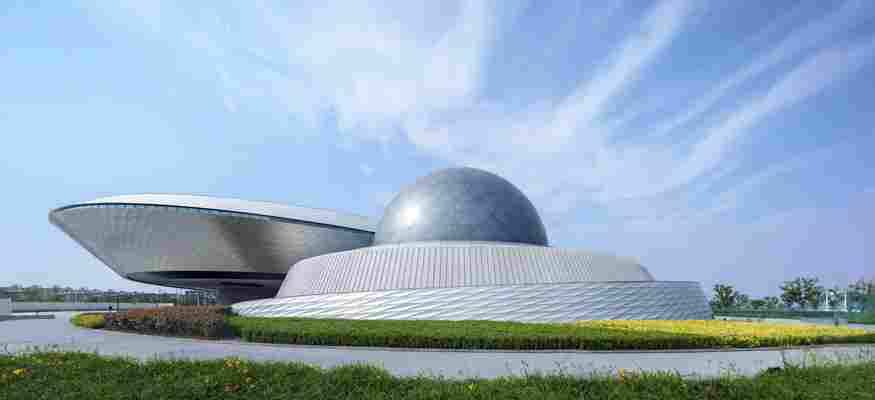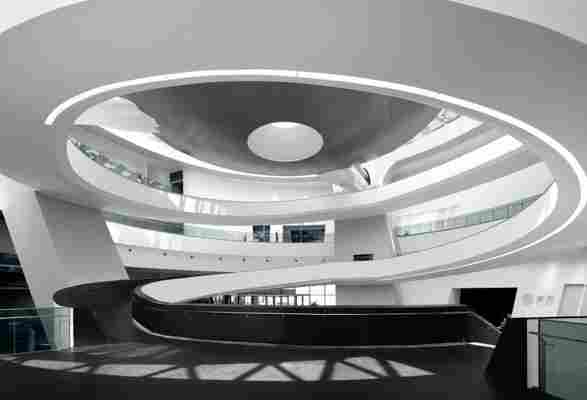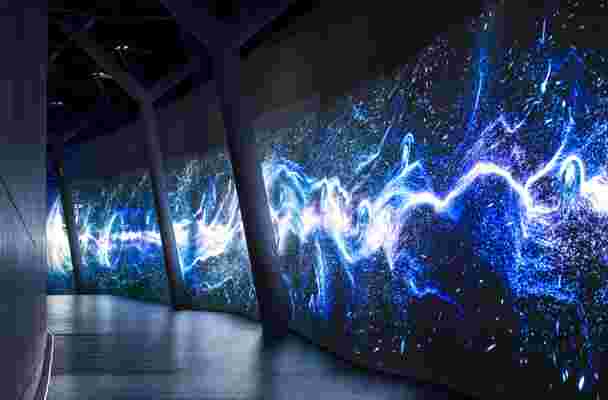Any museum can get a telescope and point it to the stars, but few can bring the wonders of the galaxy down to Earth. The new Shanghai Astronomy Museum, which recently opened in China, is potentially the world’s most majestic museum devoted to the skies. This elliptical, silvery structure looks part spaceship, part planetary invasion, with angular shapes that “embody some of the fundamental laws of astrophysics,” says the museum’s designer, Thomas J. Wong, a design partner at Ennead Architects .
The largest museum devoted to the art of astronomy, this 420,000-square-foot masterpiece is a new branch of the Shanghai Science and Technology Museum , which has landed upon a green swath of land alongside the nearby Maritime Museum and a new astronomy-themed public park, which will soon be completed.

Measuring some 420,000 square feet, this is the world’s largest museum devoted to astronomy.
That sci-fi wow factor was no accident. “The big idea was to infuse a visceral experience of astronomy into the design and deliver that before you even enter the building,” Wong says. “The building itself is conceived as an ‘astronomical instrument’ that coordinates with the path of the Sun across a day, and the changing solar altitude in our sky through the seasons.”
Ennead won the 2014 design competition to create the Astronomy Museum as a building that echoes the geometry of the universe. They previously designed the rotund, planetary-like Rose Center for Earth and Space at the American Museum of Natural History in New York. In Shanghai, one of the museum’s main highlights includes the Oculus. Suspended above the main entrance, this round design detail tracks time by sunlight throughout the day, calling back to 14th century sundials.

A view inside of the brand-new museum, located in Shanghai.
“At noon, the figure of light is most complete during any single day,” Wong says. “When the Sun is highest in the sky during summer solstice, a full and pure circle of light aligns with an inscribed circle on the plaza’s pavement.”
Science and the stars were the inspiration for the design, which focuses on the most crucial of all orbital movements, explains Wong: “The daily rotation of our Earth and its journey around our star.”

A look at one of the many exhibitions inside the museum.
Another one of the museum’s highlights is the Sphere, which looks like an enormous planet that has dropped into the core of the museum. It almost touches the ground (but not quite). This silver metallic sphere, punctured with circles, is home to a planetarium theater that tracks the Sun, Moon, and the stars. Its overwhelming size ties into Wong’s favorite Carl Sagan quote: “Our planet is a lonely speck in the great enveloping cosmic dark.”
The last and final feature along museumgoers’ way is the Inverted Dome, which is high up on the museum’s rooftop. The roof allows an unfettered view of the sky, with glass panels that look downward into the museum, offering a pause between the macro and the micro.
With ample space, the museum allows for stunningly lifelike exhibition experiences.
Above all, Wong wanted to take us elsewhere, beyond the beyond. “We wanted to highlight actual astronomical phenomena that have occurred here on Earth—things that have become more removed from our consciousness, particularly in modern urban life,” he says.
They also wanted to avoid predictable, clean lines. “We wanted the architecture to reflect the essence of the universe,” Wong says. “There are no straight lines or right angles in space.”
